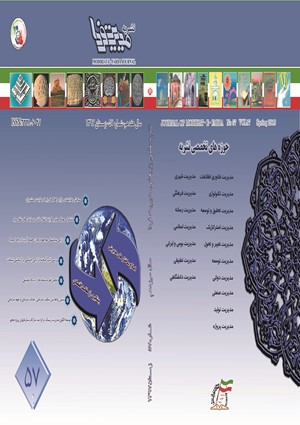Providing the best two- or multi-faceted barter between the two companies in the holding company
Subject Areas :
1 - University of Science and Technology
2 - University of Science and Technology
Keywords: Holding company Mathematical modelling Barter.,
Abstract :
The existence of debt in the accounts between a set of companies causes the items to be flooded to the left and right of the corporate balance sheet. And have misleading financial ratios for corporate finance analysts and lead to misleading predictions about the company's future. This is the case in a set of companies under the umbrella of a holding due to interactions between them and on the other hand, if there is a solution, it can be tracked and reduced due to the upstream management of the holding. In this paper, using mathematical modeling and optimization, the best combination of the two or multiple possible channels between the holding companies is suggested. How to deal with this issue is one of the issues of day care and modeling and solving it in the form of math planning is the main innovation of this article. The proposed modeling is implemented in one of the IT field holdings and its results are reported in this paper.
[1] حسن اسعدی و عیدالرضا, 1395. حاکمیت شرکتی و عملکرد شرکتهای هلدینگ و تابعه در بورس اوراق بهادار تهران. مجله راهبرد مدیریت مالی, 4, .129-151.
[2] رضا اسماعيل پور و شاهين عليجاني,1390. تحليلي بر هلدينگها (استراتژي بنگاه مادر، سبکهاي مديريتي و روشهاي ارزش آفريني. اولین كنفرانس سازمانهاي هلدينگ، تهران، ایران
[3] Augustin, P., Subrahmanyam, M. G., Tang, D. Y., & Wang, S. Q. (2016). Credit default swaps: Past, present, and future. Annual Review of Financial Economics, 8, 175-196.
[4] Bergstresser, D., & Philippon, T. (2006). CEO incentives and earnings management. Journal of financial economics, 80(3), 511-529.
[5] عثمانی, محمدقسیم, & نامدار. (2011). بررسی توانایی مولفه های جریان وجه نقدی عملیاتی در پیش بینی سودهای آتی. مطالعات تجربی حسابداری مالی, 8(31), 77-100.
[6] فرزاد پارسا, 1393. بررسی تطبیقی مقاصه و تهاتر در فقه امامیه و حقوق ایران. پژوهش های مالیه اسلامی, 2(3), 59-72.
[7] ﺳﻌﯿﺪ ﺧﺪاﻣﺮادی و ﻣﺤﻤﺪ اﺑﺮاﻫﯿﻢ, 1394. ﺷﻨﺎﺳﺎﯾﯽ و اوﻟﻮﯾﺖ روش ﺑﻨﺪی ﻫﺎیﺗﺄﻣﯿﻦ ﻣﺎﻟﯽ درﺷﺮﮐﺖ ﻫﺎ ﻫﻠﺪﯾﻨﮓ. ﻓﺼﻠﻨﺎﻣﻪ ﺳﯿﺎﺳﺖ ﻫﺎی ﻣﺎﻟﯽ و اﻗﺘﺼﺎدی، 11، 133-154
[8] فرهاد شاه ويسي, پيمان اكبري و قنبري مهرداد 1391. بررسي رابطه ميان تغيير در شاخص هاي بهره وري و تغيير در متغيرهاي مالي در شرکت هاي پذيرفته شده در بورس اوراق بهادار تهران. مجله مدیریت صنعتی, 19, 62-51
[9] مهدي علي نژادساروكلائي, صابر ساعتی 1395. اراﯾﻪ ﻣﺪل ﺗﺤﻠﯿﻞ ﭘﻮﺷﺸﯽ داده ﻫﺎي ﻣﺒﺘﻨﯽ ﺑﺮ زﻣﺎن در ﺗﺤﻠﯿﻞ ﺻﻮرت ﻫﺎي ﻣﺎﻟﯽ ﺷﺮﮐﺖ ﻫﺎي ﭘﺬﯾﺮﻓﺘﻪ ﺷﺪه در ﺑﻮرس اوراق ﺑﻬﺎدار ﺗﻬﺮان . مجله مدیریت صنعتی, 51, 65-55
[10] علی نژاد ساروکلائی و فاطمه افشار زیدآبادی, 1393.بررسی تطبیقی تحلیل صورتهای مالی شرکتهای پذیرفته شده در بورس اوراق بهادار تهران با استفاده از مدل تحلیل پنجرهای ومدل های تحلیل مبتنی بر زمان (مدلCCR خروجی محور). دانش مالی تحلیل اوراق بهادار, 7, 57-70.
[11] Sodhi. M. S (2005), LP Modeling for Asset-Liability Management: A Survey of Choices and Simplifications, Operations Reasearch, Vol. 53, No. 2, pp. 181–196.
[12] Biggs, N., 1993. Algebraic graph theory. Cambridge university press.
[13] Roberts, F.S., 1978. Graph theory and its applications to problems of society. Society for industrial and applied mathematics.
[14] Marler, R. T., & Arora, J. S. (2004). Survey of multi-objective optimization methods for engineering. Structural and multidisciplinary optimization, 26(6), 369-395.
[15] Zhang, W., & Reimann, M. (2014). A simple augmented∊-constraint method for multi-objective mathematical integer programming problems. European Journal of Operational Research, 234(1), 15-24.
(Augustin et al., 2016) (Paarsa, 2014)
(Bergstresser and Philippon, 2006)
ASADI, A. (2017). Corporate Governance and Holding Companies and Subsidiaries Performance in Tehran Stock Exchange.
(ASADI, 2017)
ASADI, A. 2017. Corporate Governance and Holding Companies and Subsidiaries Performance in Tehran Stock Exchange.
AUGUSTIN, P., SUBRAHMANYAM, M. G., TANG, D. Y. & WANG, S. Q. 2016. Credit default swaps: Past, present, and future. Annual Review of Financial Economics, 8, 175-196.
BERGSTRESSER, D. & PHILIPPON, T. 2006. CEO incentives and earnings management. Journal of financial economics, 80, 511-529.
PAARSA, F. 2014. A Comparative Study of Muqasa and Tahator in Imamia Jurisprudence and Iran's Righ. journal of islamic finance research, 2, 59-72.


